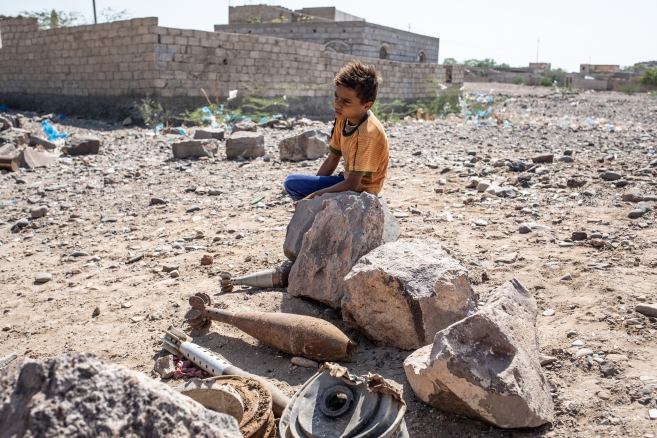March 3, 2021
INTERNATIONAL NETWORK ON EXPLOSIVE WEAPONS (INEW)
FOR IMMEDIATE RELEASE
States to resume negotiations on Political Declaration on protecting civilians from shelling and bombing in towns and cities
3 March, 2021, London, — Governments, international and civil society organisations will meet online on 3-5 March resuming negotiations of an international Political Declaration that will ultimately see states negotiate stronger rules that would protect civilians from use of explosive weapons in towns, cities and other populated areas. The negotiations have been delayed due to COVID. Final negotiations are expected to conclude later in 2021.

Yemen, Mawza, 13 December 2018 – A child is sitting near defused rockets. © MSF
Every year tens of thousands of civilians are killed and injured by bombing and shelling in towns and cities – many more suffer from the destruction of homes, hospitals, schools impacting the provision of vital services.
“States should recognise that bombing and shelling in towns and cities has devastating effects including high numbers of civilian deaths, and yet more who suffer life-changing and complex injuries, and psychological trauma from living under bombing”, said Ms. Alma Taslidzan Al-Osta, Advocacy Manager at Humanity and Inclusion.
Directly attacking civilians is illegal under international law, but too many states and other actors are using heavy explosive weapons designed for use in open battlefields in cities and towns, causing extensive harm to civilians and public infrastructure, even if aimed at a military target.
This includes heavy explosive weapons with a large destructive radius such as large aircraft bombs, weapons with an inaccurate delivery system, and those which have the capacity to deliver multiple munitions across an area such as multi-barrel rocket systems.
In World War II, it is estimated that around 60% of casualties were civilian. The urbanisation of conflict which has seen explosive weapons increasingly used in towns and cities, has meant that the proportion of civilians killed or injured has been much higher, including in Afghanistan, Syria, Yemen, Iraq, Libya, and Ukraine. New data is being released on the use of explosive weapons in 2020, which shows this pattern continue despite a decline in use from COVID.
“Data shows that when explosive weapons were used in populated areas in 2020, 88% of all casualties were civilians. The data we gathered shows that the severe pattern of harm is and will continue to cause severe harm on civilians if not addressed urgently”, said Mr. Iain Overton, Director of Action on Armed Violence.
Around 70 states are expected to take part in the consultations on 3-5 March, chaired by Ireland. INEW is calling on all states to work together to develop such a political declaration.
“States should take part in the negotiation and seek agreement on an international Political Declaration that increases the protection of civilians in conflict by avoiding use of explosive weapons with wide area effects in populated areas” said Ms. Laura Boillot, Coordinator of the International Network on Explosive Weapons.
***
For media enquiries, please contact:
Uldduz Sohrabi
+45 93 88 85 92
NOTES
What is the International Network on Explosive Weapons – INEW?
- The International Network on Explosive Weapons (INEW) is an NGO partnership calling for immediate action to prevent human suffering from the use of explosive weapons in populated areas. It comprises more than 43 organizations from across 25 countries. The steering committee is comprised of AOAV, Article 36, CIVIC, Humanity and Inclusion (HI), Human Rights Watch, PAX, Norwegian People’s Aid, Oxfam, Reaching Critical Will, Save the Children and SEHLAC – inew.org
What are the online consultations that are taking place 3-5 March 2021?
- Online, informal consultations are taking place from 3-5 March, from 14.00-18.00 CET each day, where states and organisations will share views on the draft text of an international political declaration on the use of explosive weapons in populated areas. It is chaired by the government of Ireland, and open to all interested states. Media and other interested observers can follow proceedings online at: dfa.ie/livestream
- This meeting is part of a process to negotiate an international political declaration, which is expected to conclude later in 2021.
- For more information to go Ireland’s webpage: https://www.dfa.ie/our-role-policies/international-priorities/peace-and-security/ewipa-consultations/
Where is the draft political declaration text?
- The draft declaration text is online at: https://www.dfa.ie/media/dfa/ourrolepolicies/internationalpriorities/290126-EWIPA-Political-Declaration-REV-1.pdf
- INEW’s detailed comments on the text are available at: https://www.inew.org/wp-content/uploads/2021/02/INEW_Comments_PolDecl290121.pdf
What are explosive weapons?
- Explosive weapons are conventional weapons that detonate to affect an area with blast and fragmentation. There are many types, including grenades, mortar bombs, artillery shells, aircraft bombs and missiles, as well as improvised explosive devices (IEDs). Particular concerns are focused on explosive weapons with wide area effects which – due to their scale of explosive force, or because they are inaccurate, or use multiple warheads – cause widespread damage.
What is the pattern of civilian harm?
- In 2020, at least 11,056 civilians were reported directly killed and injured by the use of explosive weapons in 48 countries/territories, according to AOAV (www.aoav.org.uk). When explosive weapons are used in populated areas, 88% of casualties were likely to be civilians. Worst affected countries in 2020 were Afghanistan, Syria, Pakistan, Yemen and Libya.
- This pattern of harm has been consistent over the last 10 years – tens of thousands of civilians killed and injured and civilians making up the vast majority of those harmed by attacks in populated areas.
- Significant wider harm is caused by the destruction of infrastructure such as houses, hospitals, schools, water and sanitation services etc. This also causes displacement and protracted challenges for reconstruction. In Raqqa, Syria, damage and destruction from US coalition airstrikes killed and injured thousands of civilians, damaged or destroyed 80% of buildings, including housing, leaving it uninhabitable and forcibly displaced nearly the entire population. See the UN’s Report of the Commission on Inquiry on Syria: https://www.ohchr.org/EN/HRBodies/HRC/IICISyria/Pages/ReportoftheCommissionofInquirySyria.aspx
- Survivors of explosive weapon use experience long term medical and psychological impacts, often in a context of inadequate support services.
What actors are using explosive weapons?
- Explosive weapons are used both by state forces and non-state armed groups. Improvised explosive devices (IEDs) have been responsible for high levels of civilian harm and are often associated with non-state violence. Professionally trained militaries are among those causing this harm. For example, in Yemen, since March 2015 at least 8,759 civilians have been killed and 9,810 injured in air raids by the Saudi-led coalition. Saudi Arabia receives significant assistance from countries like the UK. The Saudi-led campaign has been characterised by airstrikes in populated areas. See: https://yemendataproject.org/
What is the legal position?
- Explosive weapons are not illegal per se in armed conflict. Direct attacks on civilians are illegal, and this continues to be a significant cause of harm. The primary concern is use of weapons that, because of their wide area effects, cause significant civilian harm if used in a populated area – even if there is an intended military target.
Is change possible?
- Changes to military policy on the choice of weapons can reduce civilian harm. For example, between 2009 and 2014 in Afghanistan, civilian casualties from airstrikes progressively and significantly decreased year on year, because international forces (ISAF/NATO) adopted progressively stricter policies on when airstrikes could be used. Who supports action on this issue?
- Over 100 states have expressed concern at harm caused by the use of explosive weapon in populated areas. (http://bit.ly/EWIPAstates). In September 2019, UN Secretary-General, António Guterres and ICRC President, Peter Maurer, issued a further joint appeal, urging that the civilian devastation and suffering from explosive weapons in cities must stop (http://bit.ly/EWIPAJointAppeal)
